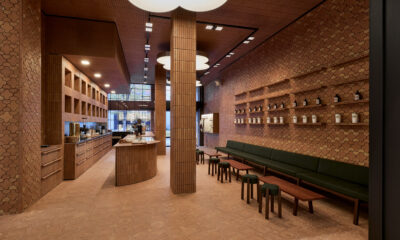Have you ever heard of a degree in window display? It doesn’t exist, because everyone comes at it sideways.” – David Hoey, Bergdorf Goodman’s resident window dresser
Visual Merchandising is often a misunderstood field. I’ve realized after speaking to college classes that real world experiences — in the store — can bring a viewpoint and insight that no textbook can provide.
Here, I’ve compiled some of the top questions I’ve answered. So take the “Vis” Quiz to test your VM knowledge — and try to have a little fun. Because no matter what your score, I’m giving you a pass.
1. Trim refers to what?
a) Being fit
b) A store’s visual directive or package
Advertisement
c) The edges of fabric
d) None of the above
e) All of the above
Answer: b)
In the visual world, “trim” refers to the store’s visual directive.
Advertisement
2. When hanging sale banners in a window what should you use?
a) Shepherds hooks
b) Monofilament string
c) Wire
d) Chain
Answer: Trick question!
Advertisement
The goal is to use whatever is less perceptible. If you are using shepherds hooks in front of a white wall, then paint them white to help camouflage them and use the longest hooks available so there is less hardware to be seen. Monofilament works great if the banners aren’t too heavy. If your brand calls for something to be seen, then by all means, use chain — but the industry standard is typically not to notice the material securing the banners.
3. There are dirty marks on a mannequin’s hand. What’s the best way to clean it?
a) Magic Eraser
b) Windex
c) Paint
d) Goof-Off Wipes
Answer: a) & d)
A Magic Eraser and Goof-Off Wipes are in the kit of almost every vm’er I know! Although, if the spot is beyond the point of no return, a fresh paint job could be the ticket. (In a pinch, you can use white nail polish to cover chips in the mannequin paint.)
4. How long should a display be left up?
a) One week.
b) One month.
c) Two months.
d) They expire?
Answer: b)
Ideally one month is the longest amount of time to leave a display up, but it really depends on the store. Just remember, two months maximum. It’s tempting to leave them up longer for budgetary reasons, but any longer than this and customers may wonder what’s wrong.
5. How do you determine if a display is effective?
a) The item it’s displaying sells out repeatedly.
b) You see customers stopping to look at it.
c) It is being photographed and copied.
d) All of the above.
e) None of the above.
Answer: e) None of the above
Although a) & c) are good indicators, quantifying the effectiveness of a display is difficult. Was it the display, marketing, the catalog or compelling graphics that pulled the customer in? A destination visit, creative display or impulse that sold the item? This is a gray area.
6. You have sunglasses that will not stick to a mannequin’s head. Your go-to item is:
a) Scotch Tape.
b) Monofilament string.
c) Zots.
d) A hat: good substitute.
Answer: c) Zots!
These little ditties stick to many surfaces and are easily removable — and they’re invisible!
7. True or False: The composition of a display window should work from left to right.
Answer: True
Visually, the eye starts to read a composition on the left hand side of a frame. When using a mannequin, place the decorative or prop on the left to middle of the window and the mannequin just to the right of it — but make sure that they’re interacting together. Depending on the trim, there are exceptions to this rule.
8. When receiving an oversized item of clothing made from a delicate fabric intended to fit a mannequin, using the following would be most effective:
a) T-pin.
b) Binder clip.
c) Silk pin.
d) A needle and thread.
Answer: b) and c)
Using a T-pin might snag delicate fabrics or leave holes too large to steam-out. A binder clip securing the fabric from the inside of the garment will adjust the fit and won’t cause any damage to the fabric. A silk pin with its sharp, small point could also be used to adjust the fit of a garment while leaving an almost imperceptible (if any) hole.
9. Name the Visual Creative Director for Barney’s N.Y.:
a) Simon Doonan
b) Laura Heritage
c) Tim Whitmore
d) Kristin Norris
Answer: Simon Doonan.
For extra visual credit who is his husband?
Answer: Designer Jonathan Adler.
10. True or False: All female mannequins wear the same shoe size.
Answer: False
It depends on the mannequins’ model, how high their vamp was created and also on the design of the shoe. One thing is universal, however, which is to make sure the mannequin’s shoes are the correct size for its feet!
11. How can you remove a screw that has been stripped from your trim?
a) Pry it out.
b) Just leave it. Who is really going to notice that box stuck to the floor forever, anyway?
c) Get someone stronger.
d) Use a rubber-band to cover the head of the stripped screw to give the drill-bit something to grip. Then reverse drill-bit direction and remove.
Answer: d)
A rubber band is a great trick that works like a charm.
12. What’s the best way to get your visual foot in the door?
a) Get in a store and work retail. Many visual veterans started from the ground-up.
b) If your store has a holiday trim install, volunteer to help.
c) Contact a local boutique and ask to help with their displays a few times a week for free.
d) Network: Take a person in the field out to lunch. You may gain a valuable mentor.
e) Always be a hard worker, you never know who you’ll meet and where it can land you.
f) Make sure your portfolio and resume are unique and different.
g) All of the above.
Answer: All of the above.
13. A typical day for a visual merchandiser might involve all of the following except:
a) Climbing up and down ladders.
b) Directing light.
c) Cleaning.
d) Styling mannequins.
e) Making commission.
Answer: e)
Although some stores may reward visual merchandisers with awards and discounts, most do not “sell” the product in the same way as the salespeople.
14. You just finished dressing a mannequin and are stepping back to check your work. Which of the following is most important:
a) All tags are properly tucked or re-ticketed in an inconspicuous area and hidden from sight.
b) All garments are properly steamed and pinned (or clipped) to show off the correct fit to the customer.
c) All marks are removed from the mannequin’s surface.
d) The mannequin’s base has been freshly cleaned and is dust- and debris-free.
e) The mannequin is properly and effectively lit to show off the merchandise.
f) The mannequin’s arms and hands have been placed in the correct position.
Answer: Trick Question!
All of these are equally important and a mannequin should never be considered finished without all of these items being accomplished.
Results:
14 out of 14 correct: You are a Visual Merchandiser!
10-14 out of 14 correct: Did I speak to your class?
5-9 out of 14 correct: You're in the industry.
Less than five correct: Call me!
Faith Bartrug of FBD Studios (Columbus, Ohio) has more than a decade of experience in transforming national brands. Her background includes brand strategy, environmental design and visual merchandising, and she has been able to practice what she preaches with leading design firms and clients such as Neiman Marcus, JCPenney and Mark Pi’s.


 Headlines1 week ago
Headlines1 week ago
 John Ryan2 weeks ago
John Ryan2 weeks ago
 Headlines7 days ago
Headlines7 days ago
 Headlines2 weeks ago
Headlines2 weeks ago
 Headlines1 week ago
Headlines1 week ago
 Retail Buzz3 days ago
Retail Buzz3 days ago
 Headlines1 week ago
Headlines1 week ago
 Headlines1 week ago
Headlines1 week ago















